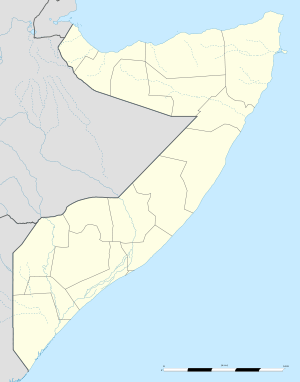Buur Heybe
| Buur Heybe | |
|---|---|
| Village | |
 Buur Heybe Location in Somalia. | |
| Coordinates: 3°00′00″N 44°19′00″E / 3.00000°N 44.31667°ECoordinates: 3°00′00″N 44°19′00″E / 3.00000°N 44.31667°E | |
| Country |
|
| Region | Bay |
| Time zone | EAT (UTC+3) |
Buur Heybe ("the mountain of the clay sand") is a small village in the southern Bay province of Somalia. It is the largest of several granitic inselbergs in the region's Doi belt.
History
The Gogollis Qabe or Gogoshiis Qabe ("the furnished place"), a local rock shelter, is the seat of the first professional excavation in the country.[1][2] In 1935, Grazioni found a Middle and Later Stone Age archaeological sequence here. The ancient implements belonged to the Somaliland Stillbay culture typified by points and scrapers produced through flat percussion flaking.[3] J.D. Clark a decade later excavated a nearby site, the Gury Waabay ("the poisonous house"), located around half a kilometer to the north.[2] In the 1980s, Brandt also excavated the granitic inselberg, uncovering a top level Holocene layer.[3] Fourteen burials were found therein, which constitute the earliest chronometrically dated burials from the Horn of Africa and contain the earliest definitive grave artefacts in the wider region.[4] A lower layer was likewise associated with the Stone Age Eibian (Doian) industry.[3] Another local rock shelter is referred to as Abka Eeden I Oboy Haawo ("Adam and Eve's court"). In addition, several rock formations in the area feature cave art.[2]
Buur Heybe historically served as a key religious and political hub.[2] According to oral tradition in the Doi ("red soil") belt, several dynasties were based in the town.[2][5] The Eyle aver that the area was at various times invaded and occupied by a succession of early Cushitic settlers, the Jidle, Maadanle and Ajuran, whom they each managed to defeat. A number of ancient burial sites dated from this pre-Islamic period sit atop the mountain's peak, and are a center of annual pilgrimage (siyaro). A trench near the holy places is said to serve as a passage toward heaven (siraad), and as such is off-limits to individuals possessing a nefarious past. These burial sites on the mountain's summit were later made into Muslim holy sites in the ensuing Islamic period, including the Owol Qaasing (derived from the Arabic "Abdul Qaasim", one of the names of Prophet Muhammad) and Sheikh Abdulqadir al-Jilaani (named for the founder of the Qadiriyya order).[2]
Additionally, the area is a center of pottery production. The Bur Ecological and Archaeological Project, established in 1983, uncovered hundreds of sherds from the site and other rock shelters. Oral tradition suggests that the Eyle were the first people to make pottery in Buur Heybe.[2]
Demographics
Buur Heybe is today primarily inhabited by the Eyle, an ethnic minority community of agropastoralists, potters and part-time hunters. Their ethnonym translates as the "hunters with dogs".[2] The Eyle are believed to be remnants of the aboriginal Khoisan hunter-gatherers who inhabited southern Somalia prior to the arrival from the north of Afro-Asiatic populations of the Cushitic branch.[6] Buur Heybe is consequently also known as Buur Eyle ("Eyle mountain"), in recognition of the first inhabitants in the surrounding villages of Howaal Dheri, Berdaale and Muuney.[2]
Notes
- ↑ Peter Robertshaw, A History of African archaeology, (J. Currey: 1990), p.103.
- 1 2 3 4 5 6 7 8 9 Mukhtar, Mohamed Haji (2003). Historical Dictionary of Somalia. Scarecrow Press. p. 60. ISBN 0810866048. Retrieved 23 August 2014.
- 1 2 3 Willoughby, Pamela R. (2006). The Evolution of Modern Humans in Africa: A Comprehensive Guide. Rowman Altamira. p. 216. ISBN 075911398X. Retrieved 23 August 2014.
- ↑ Abstracts in Anthropology, Volume 19. Greenwood Press. 1989. p. 183. Retrieved 23 August 2014.
- ↑ Jama, Ahmed Dualeh (1996). The Origins and Development of Mogadishu AD 1000 to 1850: A Study of the Urban Growth Along the Benadir Coast of Southern Somalia. Department of Archaeology, Uppsala University. p. 29. ISBN 9150611232. Retrieved 23 August 2014.
- ↑ Abdullahi, Mohamed Diriye (2001). Culture and Customs of Somalia. Greenwood Publishing Group. pp. 10–11. ISBN 0313313334. Retrieved 23 August 2014.
References
- Flora of Somalia: Angiospermaev (Tiliaceae - Apiaceae), Volume 2. Royal Botanic Gardens, Kew. 1999. ISBN 1900347776. Retrieved 23 August 2014.